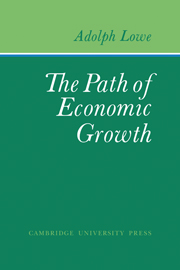Book contents
- Frontmatter
- Contents
- Preface
- Acknowledgments
- PART I The Basic Model
- PART II Changes in the Rate of Change
- PART III Changes in the Rate of Change
- PART IV Changes in the Rate of Change
- 21 The Scope of the Investigation
- 22 Dynamic Equilibrium Once More
- 23 Nonneutral Innovations: A General Survey
- 24 Pure Labor-Displacing Innovations
- 25 Pure Capital-Displacing Innovations
- 26 Some Comments on Combined Changes in the Input of Labor and Capital
- 27 Technical Progress and Diminishing Returns
- 28 Some Concluding Remarks
- Appendix: An Alternative Presentation of Lowe's Basic Model
- Glossary of Recurring Symbols
- Name Index
- Subject Index
28 - Some Concluding Remarks
Published online by Cambridge University Press: 07 October 2011
- Frontmatter
- Contents
- Preface
- Acknowledgments
- PART I The Basic Model
- PART II Changes in the Rate of Change
- PART III Changes in the Rate of Change
- PART IV Changes in the Rate of Change
- 21 The Scope of the Investigation
- 22 Dynamic Equilibrium Once More
- 23 Nonneutral Innovations: A General Survey
- 24 Pure Labor-Displacing Innovations
- 25 Pure Capital-Displacing Innovations
- 26 Some Comments on Combined Changes in the Input of Labor and Capital
- 27 Technical Progress and Diminishing Returns
- 28 Some Concluding Remarks
- Appendix: An Alternative Presentation of Lowe's Basic Model
- Glossary of Recurring Symbols
- Name Index
- Subject Index
Summary
It is not easy to sum up the gist of our deliberations. The main reason for this difficulty lies in the fact that, although the various topics discussed are all aspects of economic growth, they have been related to one another by a peculiar method of investigation rather than by the unity of their content. It is true, all these topics have as common denominator the analysis of “paths” and of “disequilibria” that must be overcome if the stipulated goal of balanced growth is to be attained. Still, this volume resembles a series of extensive monographs rather than the systematic exposition of one theme.
However, there may well be two questions left in the reader's mind to which at least a tentative answer should be given. One concerns our original claim that instrumental analysis has a better chance of arriving at empirically valid generalizations than the conventional techniques of positive reasoning. I trust that this claim has been vindicated by the manner in which, for example, the traverses required to absorb a rise or a fall in the rate of growth of labor supply or to adjust labor-displacing or capital-displacing technical changes have been treated. Given a precise definition of both the initial and the terminal state of the system and also an exact circumscription of the path criteria, it has proved possible in each case to determine, step by step, the appropriate sectoral motions of the system.
- Type
- Chapter
- Information
- The Path of Economic Growth , pp. 285 - 288Publisher: Cambridge University PressPrint publication year: 1976



